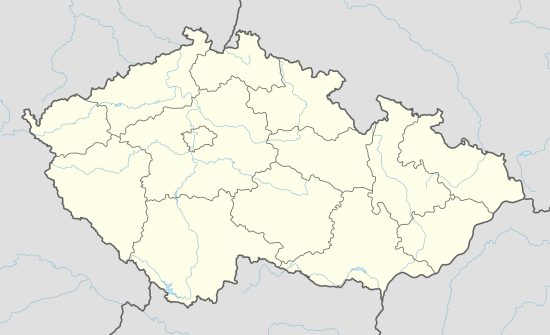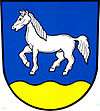Střítež (Frýdek-Místek District)
| Střítež Trzycież | |||
|---|---|---|---|
| Village | |||
|
Saint Archangel Michael Church | |||
| |||
 Location in the Czech Republic | |||
| Coordinates: 49°41′5″N 18°34′14″E / 49.68472°N 18.57056°ECoordinates: 49°41′5″N 18°34′14″E / 49.68472°N 18.57056°E | |||
| Country | Czech Republic | ||
| Region | Moravian-Silesian | ||
| District | Frýdek-Místek | ||
| First mentioned | 1305 | ||
| Government | |||
| • Mayor | Petr Machálek | ||
| Area | |||
| • Total | 6.15 km2 (2.37 sq mi) | ||
| Elevation | 365 m (1,198 ft) | ||
| Population (2006) | |||
| • Total | 1,007 | ||
| • Density | 160/km2 (420/sq mi) | ||
| Postal code | 739 59 | ||
| Website |
obecstritez | ||
![]() Střítež (Polish: Trzycież , German: Trzytiesch) is a village in Frýdek-Místek District, Moravian-Silesian Region, Czech Republic. It has a population of 996 (2001 census), 18.8% of the population are the Poles.[1] Ropičanka River flows through the village. The village lies in the historical region of Cieszyn Silesia.
Střítež (Polish: Trzycież , German: Trzytiesch) is a village in Frýdek-Místek District, Moravian-Silesian Region, Czech Republic. It has a population of 996 (2001 census), 18.8% of the population are the Poles.[1] Ropičanka River flows through the village. The village lies in the historical region of Cieszyn Silesia.
Etymology
The origins of the name are dubious. If the original name of the village was Trzeciesz it could have been patronymic in origin derived from personal name Trzeciech. Czech scribing can be related to common local names Střítež denoting damp places vegetated by deergrass. According to A. Bańkowski the name is derived from Old Polish czrzecież, equivalent to Old Czech form denoting rather hack and slash than reed (Polish: trzcina).[2]
History
The village was first mentioned in a Latin document of Diocese of Wrocław called Liber fundationis episcopatus Vratislaviensis from around 1305 as item in Trezhes.[3][4][5] It meant that the village was in the process of location (the size of land to pay a tithe from was not yet precised). The creation of the village was a part of a larger settlement campaign taking place in the late 13th century on the territory of what will be later known as Upper Silesia.
Politically the village belonged initially to the Duchy of Teschen, formed in 1290 in the process of feudal fragmentation of Poland and was ruled by a local branch of Piast dynasty. In 1327 the duchy became a fee of Kingdom of Bohemia, which after 1526 became part of the Habsburg Monarchy.
The village became a seat of a Catholic parish, mentioned in the register of Peter's Pence payment from 1447 among 50 parishes of Teschen deanery as Stzreczicz.[6] After the 1540s Protestant Reformation prevailed in the Duchy of Teschen and a local Catholic church was taken over by Lutherans. It was taken from them (as one from around fifty buildings in the region) by a special commission and given back to the Roman Catholic Church on 23 March 1654.[7] The parish is now served by the Saint Archangel Michael Church.
After Revolutions of 1848 in the Austrian Empire a modern municipal division was introduced in the re-established Austrian Silesia. The village as a municipality was subscribed to the political and legal district of Cieszyn. According to the censuses conducted in 1880, 1890, 1900 and 1910 the population of the municipality grew from 582 in 1880 to 614 in 1910 with a majority being native Polish-speakers (between 92.9% and 96.6%) accompanied by a German-speaking minority (at most 39 or 6.6% in 1900) and Czech-speaking (at most 7 or 1.2% in 1890). In terms of religion in 1910 the majority were Roman Catholics (54.7%), followed by Protestants (43.5%) and Jews (11 or 1.8%).[8] The village was also traditionally inhabited by Cieszyn Vlachs, speaking Cieszyn Silesian dialect.
After World War I, fall of Austria-Hungary, Polish–Czechoslovak War and the division of Cieszyn Silesia in 1920, it became a part of Czechoslovakia. Following the Munich Agreement, in October 1938 together with the Zaolzie region it was annexed by Poland, administratively adjoined to Cieszyn County of Silesian Voivodeship.[9] It was then annexed by Nazi Germany at the beginning of World War II. After the war it was restored to Czechoslovakia.
Footnotes
- ↑ "2001 census data". Czech Statistical Office.
- ↑ Mrózek, Robert (1984). Nazwy miejscowe dawnego Śląska Cieszyńskiego [Local names of former Cieszyn Silesia] (in Polish). Katowice: Uniwersytet Śląski w Katowicach. p. 177. ISSN 0208-6336.
- ↑ Panic, Idzi (2010). Śląsk Cieszyński w średniowieczu (do 1528) [Cieszyn Silesia in the Middle Ages (until 1528)] (in Polish). Cieszyn: Starostwo Powiatowe w Cieszynie. pp. 297–299. ISBN 978-83-926929-3-5.
- ↑ Schulte, Wilhelm (1889). Codex Diplomaticus Silesiae T.14 Liber Fundationis Episcopatus Vratislaviensis (in German). Breslau.
- ↑ "Liber fundationis episcopatus Vratislaviensis" (in Latin). Retrieved 13 July 2014.
- ↑ "Registrum denarii sancti Petri in archidiaconatu Opoliensi sub anno domini MCCCCXLVII per dominum Nicolaum Wolff decretorum doctorem, archidiaconum Opoliensem, ex commissione reverendi in Christo patris ac domini Conradi episcopi Wratislaviensis, sedis apostolice collectoris, collecti". Zeitschrift des Vereins für Geschichte und Alterthum Schlesiens (in German). Breslau: H. Markgraf. 27: 361–372. 1893. Retrieved 21 July 2014.
- ↑ Broda, Jan (1992). "Materiały do dziejów Kościoła ewangelickiego w Księstwie Cieszyńskim i Państwie Pszczyńskim w XVI i XVII wieku". Z historii Kościoła ewangelickiego na Śląsku Cieszyńskim (in Polish). Katowice: Dom Wydawniczy i Księgarski „Didache“. pp. 259–260. ISBN 83-85572-00-7.
- ↑ Piątkowski, Kazimierz (1918). Stosunki narodowościowe w Księstwie Cieszyńskiem (in Polish). Cieszyn: Macierz Szkolna Księstwa Cieszyńskiego. pp. 265, 284.
- ↑ "Ustawa z dnia 27 października 1938 r. o podziale administracyjnym i tymczasowej organizacji administracji na obszarze Ziem Odzyskanych Śląska Cieszyńskiego". Dziennik Ustaw Śląskich (in Polish). Katowice. nr 18/1938, poz. 35. 31 October 1938. Retrieved 1 July 2014.
References
- Londzin, Józef (1932). Kościoły drewniane na Śląsku Cieszyńskim. Cieszyn: Dziedzictwo błog. Jana Sarkandra. pp. 379–386. OCLC 297540848.
External links
| Wikimedia Commons has media related to Střítež (Frýdek-Místek District). |
- (Czech) Official website



